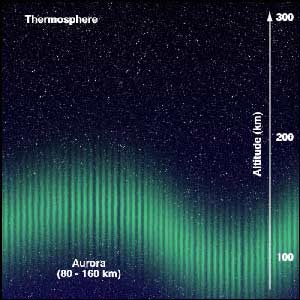 . .
|
Mesosphere (literally mean sphere)
is the third highest layer in our atmosphere, occupying
the region 50 km to 80 km above the surface of the
Earth, above the troposphere and stratosphere, and
below the thermosphere. It is separated from the
stratosphere by the stratopause and from the
thermosphere by the mesopause.

Location of the Mesosphere
Temperatures in the mesosphere drop with increasing
altitude up to about -148°F (-100°C). The
mesosphere is the coldest atmospheric layers. In fact
it is colder than the lowest temperatures recorded
in Antarctica. It is cold enough to freeze water vapor
in clouds of ice. You can see these clouds if sunlight
hits them after sunset. They are called "Noctilucent
Clouds" (NLC). NLC are more easily visible when
the sun is 4-16° below the horizon.
The mesosphere is the layer in which many meteors
burn up when entering the Earth's atmosphere. From
Earth they are seen as shooting tars.
 Dark blue layer next to the blackness of
space is the
Dark blue layer next to the blackness of
space is the
mesosphere. The upper atmosphere extends much
further.
.gif)
The highest layer is the thermosphere. The thermosphere
begins at 90-100 km and extends to 1280 km altitude.
Pressure there is almost zero and the air molecules
are very rare. Solar ultraviolet very short wavelengths
(between 100 and 200 nm) is absorbed between 100 and
150 km altitude with molecular oxygen. The temperature
increases with altitude and maintains to a level called
"thermopause" located from 250 km to 500
km along the solar activity as after thermopause temperature
between 572°F (300°C) and 2912°F (1600°C)
depending on the energy received by the Sun. Temperatures
are high, but as the matter density is extremely low
it would be very cold for us since the few air molecules
are not enough to transfer heat suitable for us. The
thermosphere is the region near the poles where the
northern and southern lights take form.

Location of the Thermosphere
The lower part of the ionosphere is called thermosphère.
The ionosphere reflects short waves (radio waves).
These waves emitted by a transmitter, bounce off the
ionosphere and are returned to Earth. If they are
turned at a certain angle, they can do almost around
the globe. The ionosphere can therefore communicate
with faraway regions.
The separation between the mesosphere the lower
limit of the thermosphere is called the mesopause.
Thermosphere is composed of two parts :
Ionosphere
is submerged in the very thin upper layer of our atmosphere
called the thermosphere. It is an ionized air in the
atmosphere layer extending from 50-60 kilometers above
the surface of the Earth to approximately 640 km.
At the magnetic equator, a phenomenon is observed
called equatorial électrojet which results
in significant movements of convection in the ionosphere.
Movements of the ionosphere are complex and depend
on many parameters such as atmospheric conditions,
solar activity, season
ie...
Ionosphere is
divided into four parts characterized by a relative
maximum of electron density :
-
D
Region extends 50-60 km to 90 km altitude.
It behaves like a sponge to face high frequency
waves passing therethrough. Much present during
the day, its ionization is directly proportional
to the solar flux, it is formed at sunrise and
sundown immediately disappears. It consists essentially
of heavy ions ( nitrogen oxide). As its absorption
is inversely proportional to the frequency bands
of 160 and 80 meters are completely absorbed during
the daylight hours.
-
E
Region region extends
from 90 to 140 km altitude. It is the lowest layer
used by radio waves to think about it. This is
a very special kind of mirror used in its two
faces, reflecting upwards and downwards. It appears
and disappears from dawn to sunset . This layer
has , at minimum solar activity, known as the
sporadic E
that we will observe in excess of 21 MHz frequency
phenomena.
-
F Region is the more ionized primarily
responsible for long-distance communication .
When solar cycle is at maximum it creates more
of ionization of F
layer,
and allows the ionosphere refract higher frequencies
(15, 12 , 10 and even 6 meters ) to the earth
for contact DX. Around the minimum of the cycle,
the sunspot number is so low that the higher frequencies
pass through the ionosphere and disappear into
space. The large number of free electrons in the
ionosphere allows the propagation of electromagnetic
waves. Radio signals - a form of electromagnetic
radiation - can " bounce " off the ionosphere
allowing radio communication over long distances.
The F
layer is ionized
at sunrise, peaked very quickly to gradually decrease
at sunset and reach its minimum just before sunrise.
During the day, the F
region is divided
into two :
-
F1 Region extending from 140 to 200
km altitude is not an important means of propagation
and whose training is directly dependent on
the sunrise and sunset. After sunset, the
F1 layer
decreases sharply to leave place for the F2
layer.
-
F2
Region extends from 200 to 250-600
km depending on solar activity. This is
the first layer that supports the high-frequency
communications. During the day, it is relatively
thin due to the presence of F1.
On the other hand, during the night, this
layer doubles its dimensions, being directly
under the influence of solar radiation,
it is very dense and allows communications
to more than 1 500 km in a single bound.

Region of the superior atmosphere
|

Simplified view of the ionosphere around
the Earth
|
Click
here to enlarge the two schemas
energy and dynamic of the thermosphere are strongly
coupled to the ionosphere as that of the lower layers
of the atmosphere. The ionosphere plays likewise,
coupled with the the
magnetosphere, a special role
in the mechanisms of loss of atmospheric chemical
species into the interplanetary environment, and as
such participates in the chemical evolution of our
atmosphere. In this region of the atmosphere the sun's
energy is so strong that it breaks the molecules and
atoms of air, leaving the ions (atoms with missing
electrons) and free electrons floating.
The ionosphere is the region of the atmosphere
where auroras occur following the Sun's activity.
They occur mostly in the F layer.

aurora borealis
Click
here to see an animated Aurora Borealis
Composite image of a beautiful
aurora observed from Polar space
by the satellite in the visible portion and ultraviolet
of the spectrum.
The ionization of air molecules in the ionosphere
is produced by ultraviolet radiation from the sun,
and to a lesser extent by high-energy particles from
the sun and cosmic
rays.
The ionization of the upper atmosphere is continuously
measured in the visible spectrum by observing the
number of spots appearing daily on the Sun , the result
of this observation is reported by Wolf
number (subjective measurement that takes into
account a factor of scale appropriate to the observer
and instrument used, finally used very little). Measurements
are also performed outside the visible band in the
UV and X bands normally absorbed by the atmosphere.
The indication of interest to the radio ham and indicates
the degree of ionization of the upper atmosphere is
a measure of solar radio flux Fs. Its direct measurement
is performed every day at 17.00 UTC on 2.800 MHz band
by the Algonquin Observatory located in Ontario (
the least subjective indication that the number of
Wolf, is available daily from the WWV from 18.18 UTC).
F is expressed in units of flux : 10-22 Wm2 HZ-1.
It can vary from 65/66 in years when solar activity
is minimum ( 66 on June 1986) to more than 300 units
at a maximum of solar activity (327 on 15 June 1989)
.
Above the ionosphere to above the upper of atmosphere
whether 640 kilometers to 10.000
kilometers is the exosphere. This is the outer thermosphere,
where the atmosphere merges with the space in the
extremely thin air. It consists of hydrogen, helium
and oxygen atoms but scarce particles collide practically
no more and behave like independent bodies subject
under the action of gravity only. It is in this area
where there are many satellites orbiting the Earth.

.gif)
WARNING
Patricia
Régnier helped me correct mistakes, please
you to visit her
blog
I’m not english speaker, some improprieties can
appear to english masters.
Could you help me reporting by mail any fault you
read. Thank you for all.
Contact :
|
|